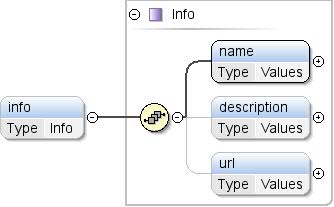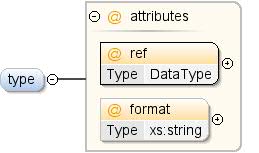Komponente: Attribut
Mit Sammlungen den Überblick behalten
Sie können Inhalte basierend auf Ihren Einstellungen speichern und kategorisieren.
| Namespace |
http://schemas.google.com/dspl/2010 |
| Annotationen |
Textinformationen zum Attribut. |
| Diagramm |
 |
| Typ |
Info |
| Attribute |
| content: |
komplex |
| minOccurs (Mindestanzahl): |
0 |
|
| Modell |
name , description{0,1} , url{0,1} |
| Children |
Beschreibung, Name, url |
| Instanz |
<info>
<name>{1,1}</name>
<description>{0,1}</description>
<url>{0,1}</url>
</info>
|
| Quelle |
<xs:element name="info" type="Info" minOccurs="0">
<xs:annotation>
<xs:documentation>Textual information about the attribute.</xs:documentation>
</xs:annotation>
</xs:element>
|
| Namespace |
http://schemas.google.com/dspl/2010 |
| Annotationen |
Der Datentyp des Attributs. |
| Diagramm |
 |
| Attribute |
| content: |
komplex |
| minOccurs (Mindestanzahl): |
0 |
|
| Attribute |
| QName |
Typ |
Behoben |
Standard |
Verwenden |
Annotation |
| format |
xs:string |
|
|
optional |
Format für den Wert, das zum Parsen eines
Darstellung der Werte. Siehe [Spezifikation für Datumsformate] für
Daten. |
| Ref. |
DataType |
|
|
erforderlich |
|
|
| Quelle |
<xs:element name="type" minOccurs="0">
<xs:annotation>
<xs:documentation>The data type of the attribute.</xs:documentation>
</xs:annotation>
<xs:complexType>
<xs:attribute name="ref" type="DataType" use="required"/>
<xs:attribute name="format" type="xs:string" use="optional">
<xs:annotation>
<xs:documentation>A format for the value, used to parse a textual
representation of the values. See [Date formats spec]
for dates.</xs:documentation>
</xs:annotation>
</xs:attribute>
</xs:complexType>
</xs:element>
|
Komplexer Typ: Attribut
| Namespace |
http://schemas.google.com/dspl/2010 |
| Annotationen |
Attribut eines Datasets oder Konzepts. |
| Diagramm |
 |
| Verwendet von |
|
| Modell |
info{0,1} , type{0,1} , (Wert*
| conceptValue{0,1}) |
| Children |
conceptValue, info, Typ,
Wert |
| Attribute |
| QName |
Typ |
Behoben |
Standard |
Verwenden |
Annotation |
| Konzept |
xs:QName |
|
|
optional |
Ein Verweis auf ein Konzept, das den Werten entspricht
des Attributs. Wenn das Attribut einen Typ angibt,
muss mit dem Typ des referenzierten Konzepts übereinstimmen. Ein Verweis auf eine
muss das Format eines externen Konzepts
„prefix:other_concept_id“, wobei „präfix“ ist
Das für den Namespace des externen Datasets verwendete Präfix (siehe XML)
Namespaces). |
| id |
LocalId |
|
|
optional |
Die ID des Konzeptattributs. Diese Kennung muss
innerhalb des Konzepts (über Attribute und Eigenschaften hinweg) eindeutig sein dürfen. Die
id [ID] kann weggelassen werden, wenn das Konzeptattribut angegeben ist. Dabei
wird implizit eine ID mit dem lokalen Namen des
Konzept verwendet. Beispiel: <attribute
concept="unit:currency"/> entspricht
<attribute id="currency"
concept="unit:currency"/> |
|
| Quelle |
<xs:complexType name="Attribute">
<xs:annotation>
<xs:documentation>An attribute of a dataset or a concept.</xs:documentation>
</xs:annotation>
<xs:sequence>
<xs:element name="info" type="Info" minOccurs="0">
<xs:annotation>
<xs:documentation>Textual information about the attribute.</xs:documentation>
</xs:annotation>
</xs:element>
<xs:element name="type" minOccurs="0">
<xs:annotation>
<xs:documentation>The data type of the attribute.</xs:documentation>
</xs:annotation>
<xs:complexType>
<xs:attribute name="ref" type="DataType" use="required"/>
<xs:attribute name="format" type="xs:string" use="optional">
<xs:annotation>
<xs:documentation>A format for the value, used to parse a textual
representation of the values. See [Date formats spec]
for dates.</xs:documentation>
</xs:annotation>
</xs:attribute>
</xs:complexType>
</xs:element>
<xs:group ref="ValuesGroup" minOccurs="0"/>
</xs:sequence>
<xs:attribute name="id" type="LocalId" use="optional">
<xs:annotation>
<xs:documentation>The id of the concept attribute. This identifier must be unique within the concept
(across attributes and properties).
The id may be omitted if the concept attribute is specified. In that case, an id is
implicity created with value the local name of the referenced concept. For instance
<attribute concept="unit:currency"/>
is equivalent to
<attribute id="currency" concept="unit:currency"/></xs:documentation>
</xs:annotation>
</xs:attribute>
<xs:attribute name="concept" type="xs:QName" use="optional">
<xs:annotation>
<xs:documentation>A reference to a concept that corresponds to the values of the attribute.
If the attribute specifies a type, then the type must match the type of
the referenced concept.
A reference to an external concept must be of the form "prefix:other_concept_id",
where "prefix" is the prefix used for the namespace of the external dataset
(see XML namespaces).</xs:documentation>
</xs:annotation>
</xs:attribute>
</xs:complexType>
|
| Namespace |
Kein Namespace |
| Typ |
DataType |
| Attribute |
| verwenden Sie zum Beispiel: |
erforderlich |
|
| Attribute |
| Aufzählung |
String |
|
| Aufzählung |
float |
|
| Aufzählung |
Ganzzahl |
|
| Aufzählung |
boolean |
|
| Aufzählung |
Datum |
|
| Aufzählung |
Konzept |
|
|
| Verwendet von |
|
| Quelle |
<xs:attribute name="ref" type="DataType" use="required"/>
|
| Namespace |
Kein Namespace |
| Annotationen |
Ein Format für den Wert, das zum Parsen einer Textdarstellung verwendet wird
der Werte. Datumsangaben findest du in den [Spezifikationen für Datumsformate]. |
| Typ |
xs:string |
| Attribute |
| verwenden Sie zum Beispiel: |
optional |
|
| Verwendet von |
|
| Quelle |
<xs:attribute name="format" type="xs:string" use="optional">
<xs:annotation>
<xs:documentation>A format for the value, used to parse a textual
representation of the values. See [Date formats spec]
for dates.</xs:documentation>
</xs:annotation>
</xs:attribute>
|
| Namespace |
Kein Namespace |
| Annotationen |
Die ID des Konzeptattributs. Diese Kennung muss eindeutig sein
innerhalb des Konzepts (über Attribute und Eigenschaften) hinweg. Die ID kann lauten:
ausgelassen, wenn das Konzeptattribut angegeben ist. In diesem Fall ist eine ID
implizit erstellt mit dem lokalen Namen des referenzierten Konzepts.
Beispiel: <attribute concept="unit:currency"/> ist
Entspricht <attribute id="currency"
concept="unit:currency"/> |
| Typ |
LocalId |
| Attribute |
| verwenden Sie zum Beispiel: |
optional |
|
| Attribute |
|
| Verwendet von |
|
| Quelle |
<xs:attribute name="id" type="LocalId" use="optional">
<xs:annotation>
<xs:documentation>The id of the concept attribute. This identifier must be unique within the concept
(across attributes and properties).
The id may be omitted if the concept attribute is specified. In that case, an id is
implicity created with value the local name of the referenced concept. For instance
<attribute concept="unit:currency"/>
is equivalent to
<attribute id="currency" concept="unit:currency"/></xs:documentation>
</xs:annotation>
</xs:attribute>
|
Attribut: Attribut / @concept
| Namespace |
Kein Namespace |
| Annotationen |
Ein Verweis auf ein Konzept, das den Werten der
. Wenn das Attribut einen Typ angibt, muss dieser übereinstimmen.
den Typ des referenzierten Konzepts. Ein Verweis auf ein externes Konzept
muss das Format „prefix:other_concept_id“ haben, wobei
„Präfix“ ist das Präfix, das für den Namespace des externen
(siehe XML-Namespaces). |
| Typ |
xs:QName |
| Attribute |
| verwenden Sie zum Beispiel: |
optional |
|
| Verwendet von |
|
| Quelle |
<xs:attribute name="concept" type="xs:QName" use="optional">
<xs:annotation>
<xs:documentation>A reference to a concept that corresponds to the values of the attribute.
If the attribute specifies a type, then the type must match the type of
the referenced concept.
A reference to an external concept must be of the form "prefix:other_concept_id",
where "prefix" is the prefix used for the namespace of the external dataset
(see XML namespaces).</xs:documentation>
</xs:annotation>
</xs:attribute>
|
Erstellt mit dem
oXygen XML Editor
Sofern nicht anders angegeben, sind die Inhalte dieser Seite unter der Creative Commons Attribution 4.0 License und Codebeispiele unter der Apache 2.0 License lizenziert. Weitere Informationen finden Sie in den Websiterichtlinien von Google Developers. Java ist eine eingetragene Marke von Oracle und/oder seinen Partnern.
Zuletzt aktualisiert: 2025-07-25 (UTC).
[null,null,["Zuletzt aktualisiert: 2025-07-25 (UTC)."],[],["The core content describes the structure and properties of an \"Attribute\" within a dataset or concept. An attribute can include optional textual information (`info`), its data `type` (required), and value. The `type` specifies the data type and can have a `format`. Attributes have an optional `id` for unique identification and can refer to another `concept`. The `info` section may include name, description, and URL.\n"]]


